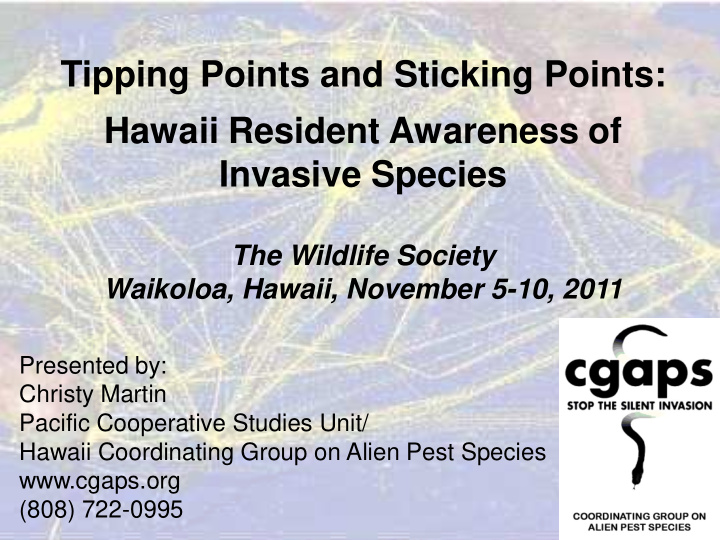



Tipping Points and Sticking Points: Hawaii Resident Awareness of Invasive Species The Wildlife Society Waikoloa, Hawaii, November 5-10, 2011 Presented by: Christy Martin Pacific Cooperative Studies Unit/ Hawaii Coordinating Group on Alien Pest Species www.cgaps.org (808) 722-0995
Most of what you will see in Hawaii is NOT NATIVE
Background: We’re Number 1, We’re number 1!! Two separate reports found that Hawaii’s alien pest problem was the worst in the nation due to the lack of a coordinated and comprehensive program to address the issue. Opportunities for Improvement: • Better communication within and between agencies • New policies and procedural changes • Raising public awareness of invasive species issues Led to the 1995 formation of CGAPS — the Coordinating Group on Alien Pest Species — is a statewide partnership of agencies and organizations working to close the gaps in Hawaii’s biosecurity system. *1992 Natural Resources Defense Council/The Nature Conservancy;1994 Office of Technology Assessment)
Invasive Species Prevention & Control Programs pre-1950: All agencies and business Hawaii Sugar Planters Association
Invasive Species P & C programs today Hawaii Agriculture Research Center
CGAPS media campaigns: 1996-1997, 2006, 2007 television, printed materials, radio ads
All: press releases, articles, letters to the ed., & opportunistic media coverage
Presentations, Public Events, Displays
General Public Awareness Have you heard of the concept known as “alien pest species” or “invasive species?” 80 70 60 Population Yes 50 40 No 30 20 Don't Know/Refused 10 0 1996 2006 2007 Year surveyed Yes: 29% in 1996 62% in 2006 70% in 2007
General Public Awareness Have you heard of the brown tree snake? 100 90 80 70 Yes 60 Population 50 No 40 30 Don't Know/Refused 20 10 0 1996 2004 2006 2007 Year surveyed Yes: 66% in 1996 83% in 2004 88% in 2006 84% in 2007
2007 Public Opinion: Tipping Point Would you support a new fee on imported cargo to support invasive species inspection? No opinion I would not 11% support I would 15% support 74% 2006: unsuccessful attempt to pass a bill taxing imports Feb. 2007: survey conducted, provided to legislators 2007: $1 on sea cargo container passes 2008: Air cargo added, standardized to $.50/1,000 lbs 2011: Fee raised to $.75/1,000 lbs
Strawberry guava: sticking point? 2008 draft EA proposing the introduction of strawberry guava’s natural biological control by USFS touched a few nerves. Why? • Case for control not adequately made (e.g., disconnect between residents and “native forest”) • Fairly successful misinformation Photo courtesy of Carnegie Airborne Observatory campaign by a local activist which won over a key support group • Location, location, location (Hawaii island is…different; Hawaii islanders have coqui, Wasmannia , nettle caterpillars, Photo: Save the Strawberry Guava etc.)
General Public Awareness If you saw a snake, how likely would you be to report it? 100 90 80 70 2004 60 Population 50 2006 40 30 2007 20 10 0 Very likely Somewhat likely Not very likely Not at all likely Response by year All years very likely, but… …every year there are between 9% and 17% that are not so sure
Tipping Point: Crime Stoppers & Amnesty Programs • Between 1990 and 2000, there was an average of 11.5 smuggled snakes recovered each year • Between June 29 and Sept 6 2011, there were 7 snakes recovered (along with 9 other illegal species) • Media began reporting the option of calling Crime Stoppers to report illegal species ($1,000 reward for information that, “brings results”) • Perhaps the media attention on the July trial & conviction in the case of the Florida toddler that was killed by the family python?
Thoughts • Plan for, and communicate early and often • Speak your neighbor’s English (pretend you are telling your story to your grandmother — simply, with respect, and try to relate to her life) • Engage professional and public spokespeople • Form relationships with the media (or, interest a PIO in your cause) • Remember, even the science that seems sensible has naysayers
Mahalo! Mahalo to the following for information, guidance, slides and/or photos: The Nature Conservancy of Hawaii, HDOA Plant Pest Control and HDOA Plant Quarantine, Lloyd Loope (USGS-BRD), Carol Okada (HDOA-PQ), Rob Hauff (DLNR-DOFAW), Fred Kraus (Bishop Museum), Philip Thomas (HEAR.org), Forest & Kim Starr (PCSU), Jack Jeffrey Photography, the Invasive Species Committees of Hawaii, and the Pacific Cooperative Studies Unit. Public awareness surveys conducted by Ward Research and Qmark Research. Christy Martin christym@rocketmail.com www.cgaps.org (808) 722-0995
Recommend
More recommend